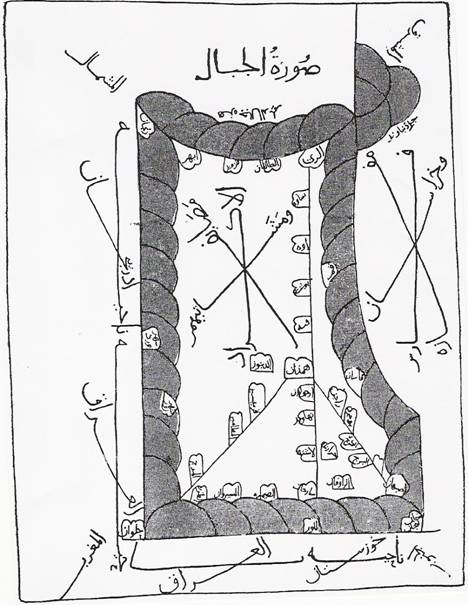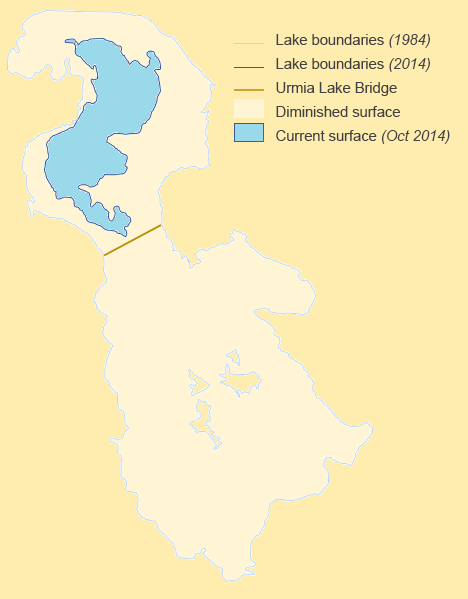|
Simineh River
The Simineh River ( fa, سیمّینه رود ), also known as the Tatavi Chay (Tatāhū Čāy), is a river in northern Iran, arising in the Zagros Mountains of Kurdistan Province north of Saqqez, that flows into the south end of Lake Urmia. It is just over long and has a catchment basin (watershed) of . Its waters are used primarily for agriculture and the return flow significantly degrades its water quality. Like its twin the Zarineh River to the east, the Simineh arises in the Zagros Mountains of Kurdistan Province and flows north through West Azarbaijan Province. Unlike its twin, the Simineh has considerably less flow into Lake Urmia. Like the rest of the steams in the basin, the river has a seasonal variability in its flow rates, but during the spring run-off the river can discharge as much as into Lake Urmia. The Simineh River flows just to the west of the city of Bukan Bukan ( fa, بوکان, translit=Bukân, ku, بۆکان, translit=Bokan) is the capital of Bukan C ... [...More Info...] [...Related Items...] OR: [Wikipedia] [Google] [Baidu] |
Iran
Iran, officially the Islamic Republic of Iran, and also called Persia, is a country located in Western Asia. It is bordered by Iraq and Turkey to the west, by Azerbaijan and Armenia to the northwest, by the Caspian Sea and Turkmenistan to the north, by Afghanistan and Pakistan to the east, and by the Gulf of Oman and the Persian Gulf to the south. It covers an area of , making it the 17th-largest country. Iran has a population of 86 million, making it the 17th-most populous country in the world, and the second-largest in the Middle East. Its largest cities, in descending order, are the capital Tehran, Mashhad, Isfahan, Karaj, Shiraz, and Tabriz. The country is home to one of the world's oldest civilizations, beginning with the formation of the Elamite kingdoms in the fourth millennium BC. It was first unified by the Medes, an ancient Iranian people, in the seventh century BC, and reached its territorial height in the sixth century BC, when Cyrus the Gr ... [...More Info...] [...Related Items...] OR: [Wikipedia] [Google] [Baidu] |
Kurdistan
Kurdistan ( ku, کوردستان ,Kurdistan ; lit. "land of the Kurds") or Greater Kurdistan is a roughly defined geo-cultural territory in Western Asia wherein the Kurds form a prominent majority population and the Kurdish culture, languages, and national identity have historically been based. Geographically, Kurdistan roughly encompasses the northwestern Zagros and the eastern Taurus mountain ranges. Kurdistan generally comprises the following four regions: southeastern Turkey ( Northern Kurdistan), northern Iraq (Southern Kurdistan), northwestern Iran ( Eastern Kurdistan), and northern Syria ( Western Kurdistan). Some definitions also include parts of southern Transcaucasia. Certain Kurdish nationalist organizations seek to create an independent nation state consisting of some or all of these areas with a Kurdish majority, while others campaign for greater autonomy within the existing national boundaries. Historically, the word "Kurdistan" is first attested in 11th ce ... [...More Info...] [...Related Items...] OR: [Wikipedia] [Google] [Baidu] |
Saqqez
Saqqez ( ; fa, سقز ; ), also known as Saghez, Saqez, Saqqiz, Saqiz, and Sakīz, is the capital city of Saqqez County in Kurdistan Province, in northwestern Iran. According to the 2016 census, its population was 165,258. Etymology The name Saqqez derives from the Scythian word "''Eskit''" and then "''Sakez''". Before that it was Izirtu, the capital of Mannaeans. In some historical sources it has been mentioned that the name of the city is derived from the name of powerful Median ruler Cyaxares (reigned 625 – 585 BC), who turned the empire into a regional power, but other historians believe that the name of the city is derived from ''Sakez'' and is attributed to the Scythians who settled in the city during the reign of Cyaxares. Demographics The city is populated by Kurds who speak the Sorani dialect. David D'Beth Hillel (d. 1846) stated that the city was home to a small Jewish community with one synagogue dating from around 1827. History Saqqez's history goes b ... [...More Info...] [...Related Items...] OR: [Wikipedia] [Google] [Baidu] |
Lake Urmia
Lake Urmia; az, اۇرمۇ گؤلۆ, script=Arab, italic=no, Urmu gölü; ku, گۆلائوو رمیەیێ, Gola Ûrmiyeyê; hy, Ուրմիա լիճ, Urmia lich; arc, ܝܡܬܐ ܕܐܘܪܡܝܐ is an endorheic salt lake in Iran. The lake is located between the provinces of East Azerbaijan and West Azerbaijan in Iran, and west of the southern portion of the Caspian Sea. At its greatest extent, it was the largest lake in the Middle East and the sixth-largest saltwater lake on Earth, with a surface area of approximately , a length of , a width of , and a maximum depth of . By late 2017, the lake had shrunk to 10% of its former size (and 1/60 of water volume in 1998) due to persistent general drought in Iran, but also the damming of the local rivers that flow into it, and the pumping of groundwater from the surrounding area. This dry spell was broken in 2019 and the lake is now filling up once again, due to both increased rain and water diversion from the Zab River by th ... [...More Info...] [...Related Items...] OR: [Wikipedia] [Google] [Baidu] |
National Geospatial-Intelligence Agency
The National Geospatial-Intelligence Agency (NGA) is a combat support agency within the United States Department of Defense whose primary mission is collecting, analyzing, and distributing geospatial intelligence (GEOINT) in support of national security. Initially known as the National Imagery and Mapping Agency (NIMA) from 1996 to 2003, it is a member of the United States Intelligence Community. NGA headquarters, also known as NGA Campus East or NCE, is located at Fort Belvoir North Area in Springfield, Virginia. The agency also operates major facilities in the St. Louis, Missouri area (referred to as NGA Campus West or NCW), as well as support and liaison offices worldwide. The NGA headquarters, at , is the third-largest government building in the Washington metropolitan area after The Pentagon and the Ronald Reagan Building. In addition to using GEOINT for U.S. military and intelligence efforts, NGA provides assistance during natural and man-made disasters, aids in se ... [...More Info...] [...Related Items...] OR: [Wikipedia] [Google] [Baidu] |
Zarineh River
The Zarrineh River ( fa, زرینهرود , lit=''golden river'' ) is a river in Kurdistan Province and West Azarbaijan Province, Iran. It is 302 km long, arising in the Zagros Mountains of Kurdistan Province south of Saqqez, where it is also known as the Jaghatu River (Jaghatu Chay)."Mahabad, Iran; Iraq" Scale 1:250,000, Series 1501 Air Sheet NJ 38-15 edition 3 February 1991, United States Defence Mapping Agency"Zarineh Rood River in Baneh" Iran Tourism & Touring Organization Its real name is Jegatoo, a well known name among local residents over centuries. Names The name ''Zarrīneh Rūd'', meaning "golden ...[...More Info...] [...Related Items...] OR: [Wikipedia] [Google] [Baidu] |
Bukan
Bukan ( fa, بوکان, translit=Bukân, ku, بۆکان, translit=Bokan) is the capital of Bukan County, West Azerbaijan Province, Iran. As of 2016, its population was estimated to be near 193,501 people or 56,000 families. The city is situated east of the Siminarud river. The whole county is populated by Shafi'i Kurds who speak Sorani Kurdish. Etymology The name Bukan derives from the Kurdish word '''brides. However, Rashid al-Din Hamadani wrote that the name was eponymous to a Merkit prince. Only during the Qajar era is the name documented. History Pre–Islamic era There have been several artefacts discovered in Bukan dating back to between 4100 BC and 4400 BC. These artefacts confirm that Bukan was home to one of the first human settlements on the Iranian Plateau. Bukan was also at the centre of the Mannaean civilization. In Pre–Islamic times Bukan was a garrison for both the Parthian Empire and the Sassanian Empire There are several ancient sites from this time period ... [...More Info...] [...Related Items...] OR: [Wikipedia] [Google] [Baidu] |
Rivers Of West Azerbaijan Province
A river is a natural flowing watercourse, usually freshwater, flowing towards an ocean, sea, lake or another river. In some cases, a river flows into the ground and becomes dry at the end of its course without reaching another body of water. Small rivers can be referred to using names such as creek, brook, rivulet, and rill. There are no official definitions for the generic term river as applied to geographic features, although in some countries or communities a stream is defined by its size. Many names for small rivers are specific to geographic location; examples are "run" in some parts of the United States, "burn" in Scotland and northeast England, and "beck" in northern England. Sometimes a river is defined as being larger than a creek, but not always: the language is vague. Rivers are part of the water cycle. Water generally collects in a river from precipitation through a drainage basin from surface runoff and other sources such as groundwater recharge, springs, ... [...More Info...] [...Related Items...] OR: [Wikipedia] [Google] [Baidu] |
Assyrian Geography
Assyrian may refer to: * Assyrian people, the indigenous ethnic group of Mesopotamia. * Assyria, a major Mesopotamian kingdom and empire. ** Early Assyrian Period ** Old Assyrian Period ** Middle Assyrian Empire ** Neo-Assyrian Empire * Assyrian language (other) * Assyrian Church (other) * SS ''Assyrian'', several cargo ships * ''The Assyrian'' (novel), a novel by Nicholas Guild * The Assyrian (horse), winner of the 1883 Melbourne Cup See also * Assyria (other) * Syriac (other) * Assyrian homeland, a geographic and cultural region in Northern Mesopotamia traditionally inhabited by Assyrian people * Syriac language, a dialect of Middle Aramaic that is the minority language of Syrian Christians * Upper Mesopotamia Upper Mesopotamia is the name used for the uplands and great outwash plain of northwestern Iraq, northeastern Syria and southeastern Turkey, in the northern Middle East. Since the early Muslim conquests of the mid-7th century, ... [...More Info...] [...Related Items...] OR: [Wikipedia] [Google] [Baidu] |




